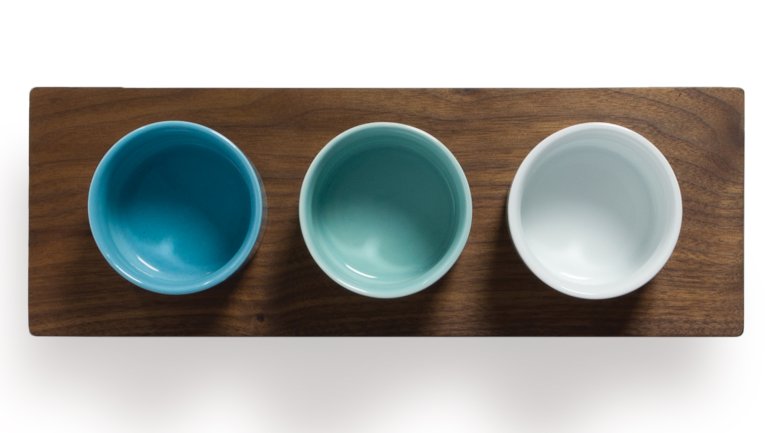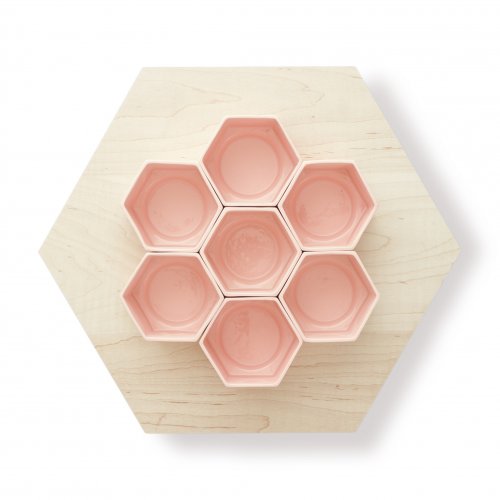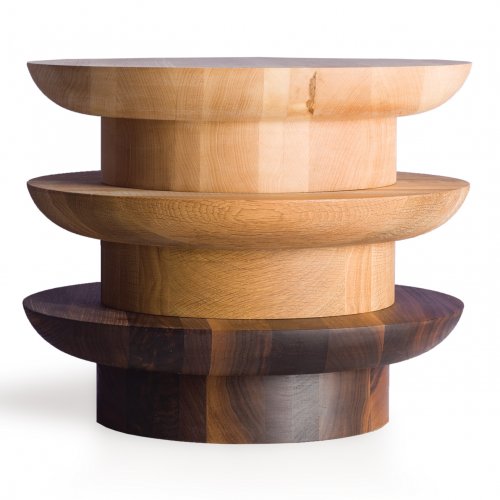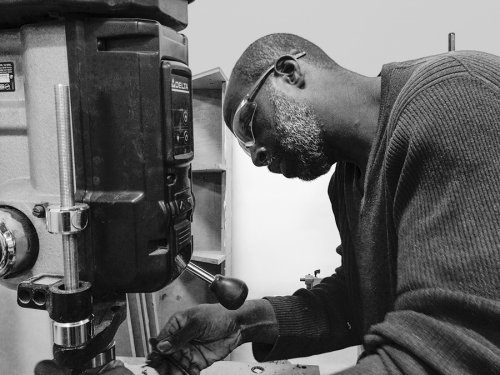D. Patterson Design Studio
D. Patterson Design Studio
Though most of D. Patterson Design Studio’s products are made for the kitchen, food is not the central inspiration for Darryl Patterson.
“I’m inspired by architects,” Patterson says. In particular, he cites modernist Mies van der Rohe, aiming for “simple lines that produce strong forms.”
That architectural connection is clear in the Baltimore designer’s serving trays and cutting boards. Each design – such as the Hive collection of hexagonal cutting boards, the two-tone Padoru serving board, and the Wa serving platter – features bold shapes and a clear purpose: to hold food and look beautiful doing it. Each emerges after a deliberative development process.
“I will do 15 different prototypes, and maybe three will make it to presentation,” says Patterson, 53. Then it’s on to his “focus group,” a community of designers and friends he trusts to give him their honest opinions. Sometimes, he says, none of his new product ideas make it past the jury.
“Does it hurt my feelings? Sure,” he says, laughing. “But, in fact, it helps me, and it motivates me. So I don’t mind it; I welcome it.”
Before D. Patterson Design Studio, which officially launched in 2013, the artist created Lottie’s Place, an annual non-juried exhibition for young and developing artists from the Baltimore area. Today, in his retail operation, he continues to work with artists from novices to veterans in product design and production.
“No one is ever put through a rigorous jury process or a brutal parsing to determine whether I will partner with them on a project,” he says. “The objective is to encourage and promote talent.”
Many of Patterson’s collaborators come from Open Works Baltimore, a makers’ space with a state-of-the-art fabrication workshop and discount memberships available to students, teachers, veterans, and those with financial need. Patterson is developing a course for Open Works called “From Concept to Commerce.” It’s a subject he knows well, thanks to his own unlikely path to woodworking.
In 2000, Patterson left his managerial job at the Food and Drug Administration, where he had worked since 1987, to follow his dream: becoming a masters-level runner with the USATF (the national governing body for track and field). In 2003, after training for three years, he was hit by a bus, fracturing his right hip and severing two-thirds of his left index finger. The accident put an end to his athletic ambitions.
“Boom – the narrative changed for me,” he says. “I was depressed for about a year. I ballooned from 165 pounds to 240 and completely gave up on running.”
Patterson’s doctors advised him to work with his hands to prevent atrophy, so he joined a woodworkers’ club in Rockville, Maryland; he returned to his day job with the FDA but continued to work with wood. In 2012, Middle Kingdom Porcelain’s Bo Jia encouraged Patterson to bring a board design to the NY Now show, where Patterson realized he could sell his work on a larger scale.
“I sort of decided, ‘You know what? This can be a business,’ ” he says. “I happened upon it, and I would not change it for the world.”
Today, between his day job, his commute, and filling orders for his increasing customer base – his work is carried in shops in 14 states, Canada, and Mexico – the artist puts in 16 to 18 hours a day. He works with the Hicksville Planing Mill in Clear Spring, Maryland, for some fabrication services (he sees them as another collaborator) but glues and finishes each piece by hand, completing up to 600 pieces each year.
“For me, it’s all about the wood grain and how to interpret that wood grain into the piece,” he says. “I don’t leave that to anyone except me.”
He continues to experiment and develop new prototypes – lately of home furnishings, including larger items like sofas. After nearly 15 years, he’s even found time to run again.
“I didn’t think that where we are now was a possibility,” he says, reflecting on his expanding business. His own experience informs his advice to others: Remain open to the unknown. “Do something. Push the ‘go’ button. Because you never know. And nothing will happen if you don’t.”
A Finer Grain
Balance: Though the artist puts in 80 to 90 hours a week, he does take time off. Two days a week, “I don’t do anything,” he says. “I have a very tolerant partner.”
In the DNA: The designer comes from a family of artists: His mother was a jazz singer, his father was a professional saxophonist, and his three siblings all draw, paint, or perform.
Small Batch: Patterson is in the process of whittling his collection of products from nearly 150 to just 30 unique items, produced in limited quantities. “I don’t want to be a serial producer,” he says.







